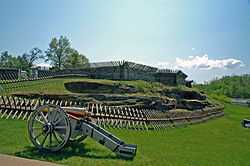Fort Prince George
Fort Prince George was an uncompleted fort on what is now the site of Pittsburgh, at the confluence of the Allegheny and Monongahela Rivers in Allegheny County, Pennsylvania. The site was originally a trading post established by Ohio Company trader William Trent in the 1740s. Fort Prince George (named for the crown prince, later King George III) was started in January 1754 by 41 Virginians in 1754. The plan to occupy the strategic forks was formed by Virginia Lieutenant Governor Robert Dinwiddie with the advice of Lieutenant Colonel George Washington, who Dinwiddie had sent on a mission to warn French commanders in late 1753, and who had made a military assessment of the site. Captain Trent was in command of the force that was constructing the fort, which was driven off by a force of 1,000 French and Indians led by Claude-Pierre Pécaudy de Contrecœur. At the time of the appearance of the French and Indians, Trent had been recalled to Wills Creek for a conference and his second-in-command, Lieutenant John Fraser, was at his own plantation at Turtle Creek on the Mononghela River, leaving Ensign Edward Ward in charge at the time of Fort Prince George's surrender on April 18, 1754. This was the first real aggression of the war, and led to George Washington's surprise attack at the Battle of Jumonville Glen.
Fraser was later court-martialled for desertion at Williamsburg but was acquitted and later served as Chief of Scouts to General Edward Braddock.
It was the first of five forts that were built to control the strategic "Forks of the Ohio". The French built Fort Duquesne after seizing the site, and the British built Fort Pitt after they captured the site in the 1758 Forbes Expedition. Mercer's Fort was a temporary British fort built to repel a French counterattack while Fort Pitt was being built. The last fort in the immediate area of what is now downtown Pittsburgh was named Fort Lafayette and was located further up the Allegheny River.
References
- Stotz, Charles Morse (2005). Outposts Of The War For Empire: The French and English In Western Pennsylvania: Their Armies, Their Forts, Their People 1749-1764. Pittsburgh: University of Pittsburgh Press. ISBN 0-8229-4262-3.
- Macgregor, Doug (2007). "The Shot not Heard Round The World". Pennsylvania History. 3 74: 354–373.
| ||||||||||||||||||||||||||||
Coordinates: 38°52′52″N 76°59′15″W / 38.88100°N 76.98746°W
